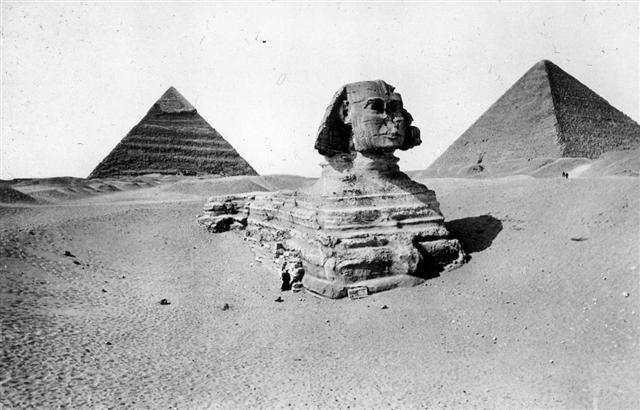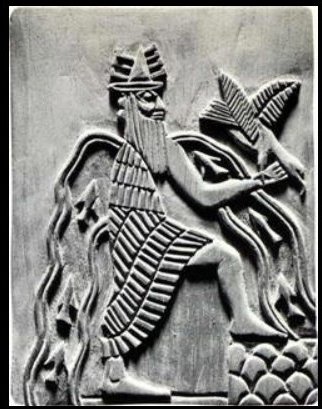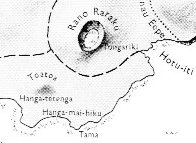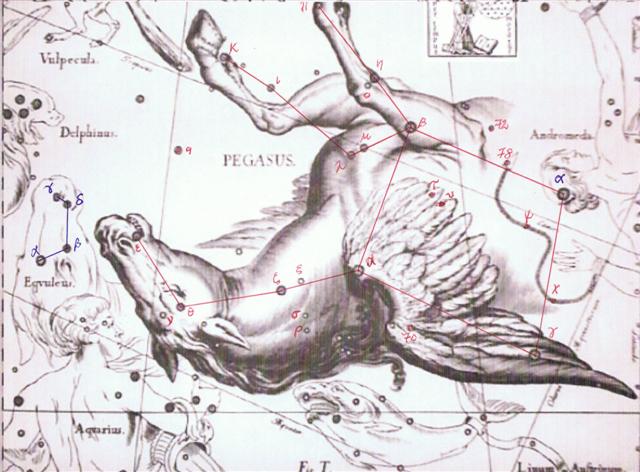Ba3.3 When the Oak Sun King (Jus-piter, Jupiter, Father Light) perished in the month which began with JUNE 10 (day 161 according to the structure of the modern Gregorian calendar), the Moon Queen would remain intact and, it seems, have donned a beard in order to carry on with his duties (at least was this the custom for the female Pharaohs in ancient Egypt). In other words she had to change her sex: ... When this tremendous task had been accomplished Atea took a third husband, Fa'a-hotu, Make Fruitful. Then occurred a curious event. Whether Atea had wearied of bringing forth offspring we are not told, but certain it is that Atea and her husband Fa'a-hotu exchanged sexes. Then the [male] eyes of Atea glanced down at those of his wife Hotu and they begat Ru. It was this Ru who explored the whole earth and divided it into north, south, east, and west ... But everyone knew it was only an apparition and even the children would have seen who was hiding behind the beard. And that the new ruler was a 'φ-male'.
So the Sun character at heliacal τ Aquarii can be understood to be the 'fi-male', which indeed Metoro seems to have perceived:
The seated figure in Ba3-1 is rising up, i.e. 'moves inlands'. The first king on Easter Island was named Oto Uta according to Manuscript E. He was like a fish (a shark) swimming ashore in the sea of winter. When a salmon at the end of his life is going back to his origin he has to swim up and away from the sea. ... This [σ Sagittarii] has been identified with Nunki of the Euphratean Tablet of the Thirty Stars, the Star of the Proclamation of the Sea, this Sea being the quarter occupied by Aquarius, Capricornus, Delphinus, Pisces, and Pisces Australis. It is the same space in the sky that Aratos designated as Water ...
... In the island of Pukapuka Te Mango, the Shark, was applied to the long dark rift which divides the Milky Way from Scorpius to Cygnus. They declared that the 'shark of winter' had its head to the south and the 'shark of summer' had its head to the north, referring to the seasonal change in the position of the constellation ... ... Here, in a very condensed form, is a typical Fijian myth of the origin of the current ruling clan (mataqali): A handsome, fair-skinned stranger, victim of an accident at sea, is befriended by a shark who carries him ashore on the south coast of Viti Levu. The stranger wanders into the interior where he is taken in by a local chieftain, whose daughter he eventually marries. From this union springs the line of Noikoro ruling chiefs, the narrator of the story being the tenth descendant on that line. He and his clansmen are called 'The Sharks' (Na Qio)... It is all as in the Hawaiian proverb: 'A chief is a shark that travels on land' ... ... Further to the east, there is Tama, whose addition 'an evil fish with a long nose' is explained by Juan Tepano to mean 'a shark' (he niuhi ME:58) [niuhi tapaka'i = hammerhead shark according to Vanaga] and may be connected with the youngest son of Hotu Matua (TP:54).
The first and third sons rule over important points along the northern and southern shore. Their domains can be said to represent the noon and the midnight sides of the island and, as such, are in contrast with each other. On the other hand, the words of the king to his second and fourth sons refer to contrasting types of behavior. It is Miru's task to watch over his people, while Hotu Iti is compared to a dangerous shark. My informants explained niuhi tapaka'i as 'como diablo' and called it an attribute for an 'hombre valiente'. Englert was not familiar with the word, but I suspect that it is related to TON. tapakaki 'to run swiftly', and I suggest the translation 'swift (?) shark', which seems an appropriate metaphor for a brave man. The contrast between Miru and Hotu Iti could be summed up as (a) the contrast between the (north)western shore and the (south)eastern shore, (b) the contrast between the 'big tribe' (mata nui) and the 'small tribe' (mata iti), and (c) the contrast between the (peaceful) 'watching over the people' and the (warlike) 'behavior of the shark' ... Open jaws ('eating' = growing) should characterize spring time and be appropriate as a sign for the 1st half of the year. Smallness implies growing, while big should denote 'no more growth' (satisfaction), i.e. the 'jaw' should be closed (as in the 2nd half of the week). There could be a 'slow shark' in the west ... ... Niuhi tapaka'i. Hammerhead shark (symbol of fierceness). Vanaga. Shark. T (ninki T). Mq.: niuhi, a large fish resembling the shark ... And from there - i.e. from the heliacal Rain star Matar - the text continues with days related to the Sun and corresponding to the 16 nights until Matar (η Pegasi) would return to visibility:
The leg in front was converted into a sign of hipu (similar to how the male king was emasculated and contorted into a queen), and this season continued until 3-14.
From where 2 nights later the 'fire' (ahi) would be on his way to return again (hoki). Ahi. Fire; he-tutu i te ahi to light a fire. Ahiahi = evening; ahiahi-ata, the last moments of light before nightfall. I te ahiahi-ata he garo te raá ki raro ki te vai kava. In the evening the sun disappears under the sea. Ku-tea-á te hetu'u ahiahi, the evening star has risen. Vanaga. 1. Candle, stove, fire (vahi); ahi hakapura, match; ahi hakagaiei, firebrand waved as a night signal. P Mgv.: ahi, fire, flame. Mq.: ahi, fire, match, percussion cap. Ta.: ahi, fire, percussion cap, wick, stove. 2. To be night; agatahi ahi atu, day before yesterday. 3. Pau.: ahi, sandalwood. Ta.: ahi, id. Mq.: auahi, a variety of breadfruit. Sa.: asi, sandalwood. Ha.: ili-ahi, id. Ahiahi, afternoon, night; kai ahiahi, supper. P Pau., Mgv., Mq., Ta.: ahiahi, afternoon, evening. Ahipipi (ahi 1 - pipi 2) a spark, to flash. Churchill. The upside down (dead) Flying Horse has η (Matar, *344) on his right front leg and 15 right ascension nights later was *359 at the star 78 Pegasi, to which the left hand of Andromeda was chained. Spring equinox would arrive at Sirrah (the 'Navel' - place of birth - of the Horse, α Andromedae) about a week later (*359 + *7 = *366), where Maui would be born. Ba3-16 + 7 = Ba3-23:
|
||||||||||||||||||||||||||||||||||||||||||||||||||||||||||||||||||||||||||||||||||||||||||||||||||||||||||||||||||||||||||||||||||||
























